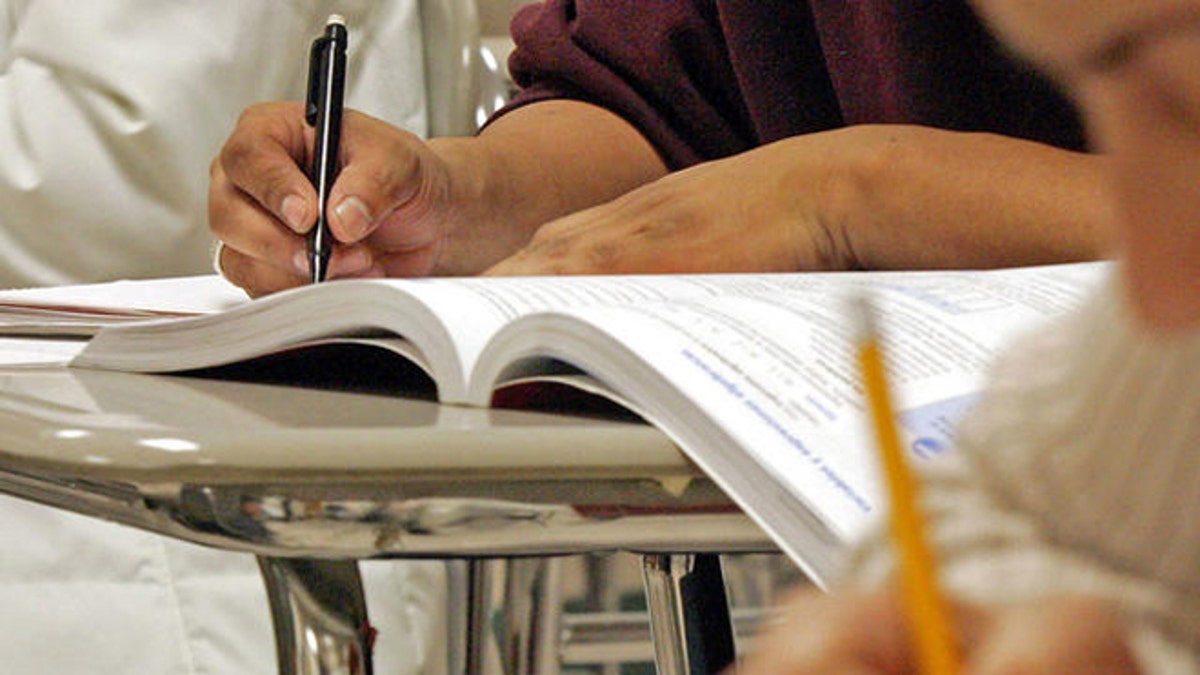
Students work out math problems during a class for Hispanic adults. (AP Photo/ Karl DeBlaker)
Mexico City – When 36-year-old Jan García from Monterrey, Mexico, went to study for a bachelor’s degree in education in Minnesota 15 years ago, she quickly realized that her professional future lay in the classroom.
Yet her dream of teaching English to elementary school children in Mexico was complicated by the country’s highly-politicized public education system which refused to recognize her qualification.
“If there’s one thing I knew after I came back from the U.S., it’s that I wanted to be a teacher and put my degree to good use,” García, who currently teaches English at a private school in Puebla, told Fox News Latino. “But it’s hard for dedicated, qualified teachers to prosper in Mexico because of the bureaucracy involved.”
Now, however, García sees a new route to fulfilling her dream. She is currently planning to study her master’s degree in Teaching English as a Second Language (TESOL) at a U.S. university and pay her way by teaching in the public school system where demand for Spanish-speaking educators is growing.
“Going back to the states would be a dream come true,” she said. “I want to go somewhere where my skills are valued and I can really make a difference.”
- Best pix of the week
- Mexico’s disabled cowboys defy expectations and traditions
- Venezuelan children fainting in school because they are hungry
- Baseball’s new Spanish-language translators already making a big difference
- Cuban entrepreneurs build network of private schools
- Mexico mourns the loss of beloved singer Juan Gabriel
García is looking to benefit from an increasingly integrated economic and cultural relationship between the U.S. and Mexico where the growing demand for bilingual education on both sides of the border is just one example of how the two countries are moving ever closer.
According to the Pew Hispanic Center, 35.8 million people in the U.S. speak Spanish at home. In 2014, 9.3 percent of all children in the U.S. public school system were learning English as a second language, while in Latino-heavy California, the number was 22.7 percent.
But while the number of children in U.S. schools who struggle with English has grown across the country, the number of bilingual teachers has not kept up with that growth.
That has school districts across the country – particularly ones where the disparity is pretty alarming – looking to Latin America to fill in the gap.
School districts increasingly look overseas to Puerto Rico, Spain and Mexico for teachers. Nearly 16,000 arrived from Latin America between 2008 and 2013, according to the Migration Policy Institute.
“It’s a great opportunity for qualified Mexican teachers, many of whom are extremely capable but struggle to find suitable positions at home,” Guy Courchesne, a Canadian whose company Teachers Latin America recruits teachers moving in both directions, told Fox News Latino.
Demand for English-language learning in Mexico is also growing. According to a 2015 survey by the British Council in Mexico City, 40 percent of Mexicans speak some level of English and 69 percent of companies in the country view proficiency in the language as a key factor in hiring personnel.
Mexico’s own public education system is notoriously poor, sitting at the bottom of the Organization for Economic Co-operation and Development (OECD) rankings. Because of that, international schools – which often rely on foreign teachers for their English-heavy curriculum – are booming in Mexico.
Once the preserve of children of diplomats, American expats and businesspeople, an increasing number of Mexican families are now opting to send their kids to international schools.
“It’s not only a case of learning English, which is vitally important, but also parents see it as a way for their kids to make the social connections they will need to get ahead when they enter the job market,” Mary-Jo Gill, director of the Westhill Institute in Mexico City, told Fox News Latino.
The demand is drawing American teachers like Leigh Thelmadatter from New York, who obtained a master’s degree in TESOL from the University of Arizona in 2003, yet found that well-paid opportunities to teach English as a second language to adults in the U.S. were scarce.
She has spent the past 13 years working at the prestigious Monterrey Institute of Technology’s campus in Mexico City, where she lives with her Mexican husband and has no intention of leaving the country.
“It was a case of wanting to teach English as a second language and having to go where the demand was, which happened to be Mexico,” Thelmadatter told FNL.
In many cases, teachers are not only employed to teach languages but also an entire range of subjects, as the curricula in both countries become increasingly bilingual.
“There’s a need not only for language instruction in K-12 classrooms, but also for other core subjects such as science, history and math which are increasingly taught in English in Mexico and in Spanish in the U.S.,” said Teachers Latin America’s Courchesne.
For teachers like Jan García, the demand enables her to fulfil a dream that has been long in the making.
“Studying education in the U.S. gave me a whole new perspective on the joys and challenges of teaching,” she told FNL. “Returning would be a great opportunity to give something back.”
